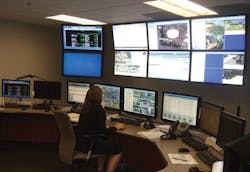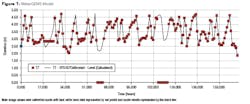Understanding Calibration of Water Distribution Models
By Tom Walski
Hydraulic models of water distribution systems are a standard tool for engineers and operators working for water utilities and their consultants. These computer programs can solve the hydraulics and water quality equations for huge water systems quickly and accurately. There are two overall categories of model runs — steady simulation, which looks at what is essentially a snapshot of the system at a point in time; and extended period simulations (EPS), which track the behavior of the system over time.
Bentley's Tom Walski discusses how hydraulic modeling can benefit not only water utility engineering staff but also operations. Examples are presented.
Need for Calibration
In order to have faith in the results of a distribution system model, it is important to calibrate the model against real-world data. This process consists of comparing model results with data collected from the field, identifying areas where the model and the field disagree, determining the reasons for any discrepancies and making the necessary adjustments to bring the model into calibration.
This process sounds straightforward but it is not easy. Part of the difficulty is that there are many reasons for a model not to calibrate well. These can include such things as: errors in the connectivity of the pipe network from the original data source, which could be the GIS/CAD maps used to build the model; incorrect demand data (either magnitude or location) for the time of the model; incorrect elevations for model nodes or the pressure sensors providing data; inaccurate pipe roughness data; inaccurate pump curves; incorrect valve status or settings; pressure zone divide errors; inaccurate sensors; incorrect pump status or speed; inaccurate tank water levels; and many more subtle reasons. The challenges are daunting for steady models but the sources of errors — and difficulty — increase significantly when EPS models are involved.
Calibration of an EPS model usually requires the collection of time series values for flows, pressures, tank water levels and pump/valve status from the utility’s SCADA (Supervisory Control and Data Acquisition) system or data logging equipment and overlaying that data on top of model results.
Moving the model closer to the control room helps keep the model more closely aligned with the real system.
Calibration Challenges
The difficulty in calibration involves all of the sources of error from the steady model calibration exercise plus numerous additional sources of error. The model must not only know the pump/valve status but be able to predict when the status changes. It must not only accurately represent demands but also know how the demands vary over the course of time.
Calibration is usually accomplished by collecting data from a one day period and taking the necessary steps to reconcile the model with the real-world data. To ensure that the calibration is correct, it is desirable to verify the model by comparing the results within an independent data set. Invariably these results are not as good as for the original calibration. What went wrong? Plenty.
If an EPS model is calibrated for a given day, then it is most valid for that day. As water use patterns and operator decision-making deviate from the day, the model becomes less valid.
The bad news is that no two days are identical. Who knows who is flushing their toilet or taking a shower at 10 a.m.? This author once did an analysis of demand patterns and found that there can be up to about a 15 percent difference in demand at any time of day for no real reason — just random human behavior. In addition, distribution operators do not make exactly the same decisions every day and there are special events such as fires or pipe breaks that can alter data.
The good news is that these variations don’t impact the model results very much. Especially in North America, where fire flow requirements are large, the velocity — hence, headloss — in most pipes is small so that variations in daily demand have only a small impact on pressure. The biggest impact usually is that tanks will fill more slowly and drain more quickly as the demand increases. This shows up in the model as time shifts in pump on-off times. But the results in terms of hydraulic grade, pressure, etc., are still quite good.
It would be great if a modeler could calibrate the model over many significantly different kinds of days. This is more costly than a one-shot calibration but as one moves past the first day, subsequent days are not nearly as difficult to calibrate. The more significantly different the days for which the model is calibrated and verified are, the greater the confidence that model users can have in its results. But this involves additional time and money, which are not always available.
It’s important to remember that model calibration is not a black and white situation. No model is perfect. The better the calibration and the more closely the condition being analyzed approaches that for the calibration day(s), the closer the results are to perfect.
SCADA Data
One of the big problems in attempting to calibrate a model over a long period of time is the need for a great deal of data. Most water utilities collect huge quantities of data with their SCADA and AMR systems but it is often difficult for modelers to get at this data in a useful form. Data often lies on the SCADA side of a firewall or air gap and modelers cannot readily access it. Furthermore, providing data to modelers is not always at the top of the operator’s priority list.
Real-Time Modeling
An improved approach is to run the model as a real-time model. With this approach, the model is tightly integrated with the SCADA system. Modelers can get at the data readily or the model can be run in the operational control room.
Every day, the modeler (whether in the engineering group or the operations group) can get the previous day’s SCADA data and compare it with the model. Some days will agree well. On days that don’t, the modeler can identify the source of the difference, whether it was a fire, an incorrectly closed valve, a pipe break, flushing, unusual weather, a special event, a new pump, new land developments, a large shutdown, bad SCADA signal, etc. As these discrepancies are resolved, the calibration improves, everyone’s confidence in the model and SCADA system increases, and operators begin to understand and rely on the model.
The benefit of this approach is that when there is an operational problem the model is ready to go and support decision-making because the model is continuously calibrated to match today’s conditions. If a call comes in to the control room that there is a large fire or a major pipe break, it is possible to quickly use the model to help evaluate response to the situation. Bentley’s SCADAConnect feature in WaterGEMS makes this process easy.
The integration of real-time modeling with operation can help ensure that the model is ready to run to provide decision support for operations and provide the water utility with a great return on its investment in the model. WW
About the Author: Tom Walski is senior product manager for water and wastewater products for Bentley Systems. He holds a Ph.D. in environmental and water resources engineering from Vanderbilt University and has authored several books as well as several hundred journal papers and conference presentations. He co-holds seven patents for hydraulic analysis techniques. In previous positions, Walski has served as an executive director of the Wyoming Valley Sanitary Authority, engineering manager for Pennsylvania American Water, associate professor of environmental engineering at Wilkes University, an engineer with the Army Corps of Engineers, and manager of distribution system operation for the City of Austin, Texas.



